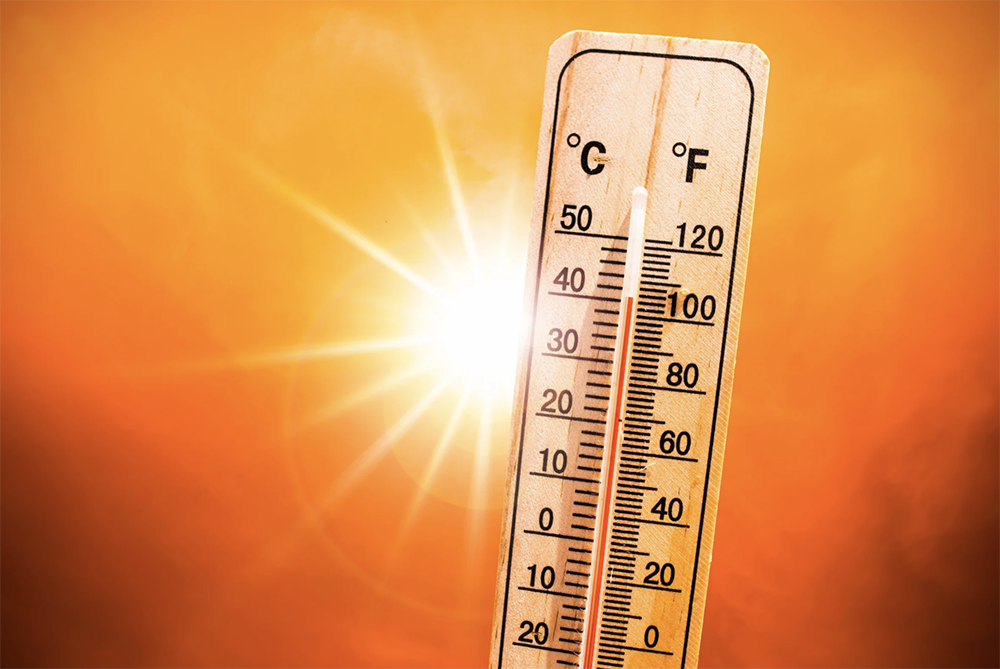Well, that changed fast. June gloom went to summer sizzle. High temperatures were in the 60s as recently as June 16 inland, and June 17 at the shore. Less than a week later, inland areas sweltered in the heat and humidity. Inland highs were in the 90s, with the sultry weather peaking earlier this week.
In other words, the pattern shift from spring to summer is now done, like we talked about in last week’s column about the cool and wet weekends. While the official temperatures are not in at the time of this writing, it’s likely you have lived through your first heat wave of 2025 inland.
With the heat increasing, both in the short term and the long term, knowledge is key to staying prepared.
What is a heat wave?
A heat wave in New Jersey is defined as three or more days of high temperatures at or above 90 degrees.
Turns out, there is no official definition of a heat wave. The National Oceanic and Atmospheric Administration defines it as “a period of abnormally hot weather generally lasting more than two days.”
The American Meteorological Society says “to be a heat wave, such a period should last at least one day, but…lasts from several days to several weeks.”
The idea of using 90 degrees stems from A.T. Burrows. In 1901, he said a heat wave was when there were three or more days of heat that were above 90 degrees.
While we use that definition in New Jersey now, that doesn’t make sense for the Deep South. Jackson, Miss. has an average high temperature in the 90s from June 11 to Sept. 8. While it’s hot, that’s part of their climate.
Moreover, that doesn’t work in Seattle, where they average 2.5 days in the 90s each year, according to the Iowa Environmental Mesonet.
Heck, it doesn’t even really work in the beach towns here in New Jersey.
The Sen. Frank S. Farley State Marina in Atlantic City averages 4.4 days a year with a temperature of at least 90 degrees. Using the New Jersey heat wave definition, the last one for the city was July 2011.
You can figure the same for all of the barrier island beach towns at the Jersey Shore (note that most Monmouth County beaches are not barrier islands and see highs of at least 90 degrees more often, but still not as often as inland towns).
In 2022, I asked those in the local weather news space to comment about what a heat wave is for their viewing area. Central California goes by three days of 100 or more heat. In Amarillo, Texas, it’s three days of 105 heat. In Austin, it’s a week at least in the 100s.
Has New Jersey seen more heat waves over time? To keep it simple, we’ll just use the three days over 90-degree threshold for both the beach towns and inland areas.
Plus, to keep the answer simple, yes there has been an increase in the number of heat waves over time. Here are the number of heat waves, per decade at Atlantic City International Airport per the Iowa Environmental Mesonet.
- 1940s: 11
- 1950s: 13
- 1960s: 17
- 1970s: 14
- 1980s: 24
- 1990s: 22
- 2000s: 28
- 2010s: 36
- 2020-2024: 20 (on pace for 40)
Most of that increase has been during July and August, our two hottest months of the year. Nowadays, you can expect about four heat waves a year.
Go to the coast and there’s also an increasing trend in Atlantic City. However, since there are so few of them, with the last being in 2011, it’s not as strong of an increase as inland areas. Plus, there’s no real change in what month they’re happening more often.
Remember, too, that the threshold is 90 degrees. A week with 90s, except one for one day where it’s 89, would count as two heat waves instead of one. Still, the data shows an overall increase in the number of 90-degree days throughout the region. That’s especially true for the airport, which is always warmer than the coast in the summer.
What’s causing the increase in heat waves?
Human influence on Earth is mainly responsible for this increase in two different ways.
First, there’s been an increase in greenhouse gas emissions since the Industrial Revolution in the 1700s. The more carbon dioxide, methane, etc. that is in the atmosphere, the greater the ability for the sun’s heating rays to hit the ground, reflect back into the sky, only to bounce back down again off the emissions.
Secondly, there is an increase in roads, roofs and parking lots. These dark surfaces absorb more heat than the green gas, trees or the white sand. So, when the sun is down at night, that stored-up heat releases itself into the atmosphere, keeping our air warm (weather stations take readings about 6 feet high).
Summer heat safety tips
Staying healthy during heat waves requires some changes in lifestyle. Staying in the air conditioning, if you have it, is your best defense against the scorching heat. During the summer, the state of New Jersey works with towns and counties to open cooling shelters by you.
In Atlantic County, the county libraries in Absecon, Egg Harbor Township, Mays Landing, Pleasantville and Somers Point are open for you. If you’re in Cape May County, the emergency management website provides a list of cooling shelters when needed.
Deciding to go to the beach or pool to cool off is a great idea. However, even going there can be hazardous on the hottest days. The salt water at the beach can dry you out, and you’re still feeling the humidity next to the ocean. Drink plenty of water.
If you’re working outside, you should have 8 ounces (a cup) of cool water every 20 minutes. Take frequent breaks, between 10 a.m. and 4 p.m., when the sun is strongest. If you can do that in the shade, it’s even better.
Finally, know the symptoms of heat exhaustion or heat stroke. Heat exhaustion brings thirstiness, heavy sweating, nausea and weakness.
You can combat this by moving to a cooler area, loosening clothing and sipping water. I had heat exhaustion in Italy in 2019. If you know Europe, you know air conditioning is optional, despite Italy being as hot as it is here. Going into a museum, I got nausea and sweated heavily. We took a car back to our hotel room where we put the air conditioning on as low as possible. I was done for the rest of the day, but much better by nightfall.
Heat stroke, meanwhile, is a medical emergency. Call 9-1-1, get into a cooler spot and get ice on you as soon as you can.
Heat is the biggest killer in the United States, unfortunately. It has been every year since 2016, according to NOAA. However, just a little extra attention to what you are doing outside during heat waves goes a long way.
Joe Martucci, a Certified Broadcast Meteorologist and Digital Meteorologist, is the President and Director of Meteorology for Cup A Joe Weather and Drone. You can connect with him at cupajoe.live.













